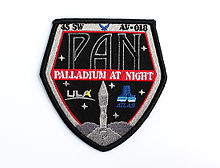- USA-207
-
USA-207 Operator Classified Major contractors Lockheed Martin[1]
ULA (LSP)Bus A2100 Mission type Communications Launch date 8 September 2009
21:35 GMTCarrier rocket Atlas V 401 Launch site Cape Canaveral SLC-41 USA-207,[2], international COSPAR code 2009-047A,[3] also known as PAN, officially meaning Palladium At Night,[4] or P360[5] is a classified American communications satellite,[6] which was launched in September 2009. The US government has not confirmed which of its intelligence agencies will operate the satellite.[7] The spacecraft was constructed by Lockheed Martin, and is based on the A2100 satellite bus,[4] using commercial off-the-shelf components.[5] The contract to build PAN was awarded in October 2006, with the satellite initially scheduled to launch 30 months later, in March 2009.[8]
PAN was launched by United Launch Alliance using an Atlas V 401 carrier rocket, with the serial number AV-018. The launch, from Space Launch Complex 41 at the Cape Canaveral Air Force Station, occurred at 21:35 GMT on 8 September 2009, at the start of a 129 minute launch window.[9] PAN successfully separated from the rocket just under two hours after liftoff.[10]
PAN has shown an unusual history of frequent relocations, moving between at least four different orbital slots since launch: as of early May 2011 it is located at 44.9 deg E.[11], over East Africa.
References
- ^ Ray, Justin (2009-07-09). "Atlas rocket team continues active year of launches". Spaceflight Now. http://spaceflightnow.com/atlas/av018/090709status.html. Retrieved 2009-08-31.
- ^ McDowell, Jonathan (2009-09-10). "Issue 615". Jonathan's Space Report. Jonathan's Space Page. http://www.planet4589.org/space/jsr/back/news.615. Retrieved 2009-09-11.
- ^ "Spacewarn Bulletin Issue 671". NASA NSSDC. 2009-09-30. http://nssdc.gsfc.nasa.gov/spacewarn/spx671.html. Retrieved 2011-07-06.
- ^ a b Day, Dwayne (2009-08-24). "PAN’s labyrinth". The Space Review. http://www.thespacereview.com/article/1450/1. Retrieved 2009-08-31.
- ^ a b "New Horizons". Lockheed Martin. December 2007. p. 7 (5 of PDF). http://www.lockheedmartin.com/data/assets/ssc/071204a.pdf. Retrieved 2009-09-06.
- ^ US Air Force 45th Space Wing (2009-09-04). "Atlas V set for Cape Launch Sept. 8". Florida Today. http://www.floridatoday.com/content/blogs/space/Atlas%20V%20PAN%204Sep09%20Launch%20Media%20Advisory%2009-09-02-1.doc. Retrieved 2009-09-05.
- ^ Covault, Craig (2009-05-26). "Secret PAN satellite leads Cape milspace launch surge". Spaceflight Now. http://www.spaceflightnow.com/news/n0905/26milspace/. Retrieved 2009-08-31.
- ^ "Highlights". Lockheed Martin Space Systems Company. Spring 2007. pp. 28 (29 of PDF). http://www.lockheedmartin.com/data/assets/14445.pdf. Retrieved 2009-09-06.
- ^ Clark, Stephen. "Worldwide Launch Schedule". Spaceflight Now. http://www.spaceflightnow.com/tracking/index.html. Retrieved 2009-08-31.
- ^ Malik, Tariq (2009-08-30). "Atlas 5 Rocket to Secret Satellite [sic]". Space.com. Archived from the original on 2009-08-31. http://www.webcitation.org/5jRi8wiAc. Retrieved 2009-08-31.
- ^ "SatTrackCam". http://sattrackcam.blogspot.com/2011/05/unid-i-3-may-2011-pan.html. Retrieved 2011-05-09.
← 2008 · Orbital launches in 2009 · 2010 → USA-202 | Ibuki · SDS-1 · Sohla-1 · Raijin · Kagayaki · Hitomi · Kukai · Kiseki | Koronas-Foton | Omid | NOAA-19 | Progress M-66 | Ekspress-AM44 · Ekspress-MD1 | Hot Bird 10 · NSS-9 · Spirale-A · Spirale-B | OCO | Telstar 11N | Raduga-1 | Kepler | STS-119 (ITS S6) | GOCE | USA-203 | Soyuz TMA-14 | Eutelsat W2A | USA-204 | Kwangmyŏngsŏng-2 | Compass-G2 | RISAT-2 · ANUSAT | Sicral-1B | Yaogan 6 | Kosmos 2450 | USA-205 | Progress M-02M | STS-125 | Herschel · Planck | ProtoStar II | TacSat-3 · PharmaSat · AeroCube 3 · HawkSat I · CP-6 | Meridian 2 | Soyuz TMA-15 | LRO · LCROSS | MEASAT-3a | GOES 14 | Sirius FM-5 | TerreStar-1 | Kosmos 2451 · Kosmos 2452 · Kosmos 2453 | RazakSAT | STS-127 (JEM-EF · AggieSat 2 · BEVO-1 · Castor · Pollux) | Kosmos 2454 · Sterkh-1 | Progress M-67 | DubaiSat-1 · Deimos-1 · UK-DMC 2 · Nanosat 1B · AprizeSat-3 · AprizeSat-4 | AsiaSat 5 | USA-206 | JCSAT-RA · Optus D3 | STSAT-2A | STS-128 (Leonardo MPLM) | Palapa-D | USA-207 | HTV-1 | Meteor M-1 · Universitetsky-Tatyana-2 · Sterkh-2 · UGATUSAT · BLITS · SumbandilaSat · IRIS | Nimiq 5 | Oceansat-2 · BeeSat-1 · UWE-2 · ITU-pSat1 · SwissCube-1 · Rubin 9.1 · Rubin 9.2 | USA-208 · USA-209 | Soyuz TMA-16 | Amazonas-2 · COMSATBw-1 | WorldView-2 | Progress M-03M | USA-210 | Thor-6 · NSS-12 | SMOS · Proba-2 | Progress M-MIM2 (Poisk) | Shijian XI-01 | STS-129 (ExPRESS-1 · ExPRESS-2) | Kosmos 2455 | Intelsat 14 | Eutelsat W7 | IGS Optical 3 | Intelsat 15 | USA-211 | Yaogan 7 | Kosmos 2456 · Kosmos 2457 · Kosmos 2458 | Yaogan 8 · Xi Wang 1 | Helios IIB | Soyuz TMA-17 | DirecTV-12Payloads are separated by bullets ( · ), launches by pipes ( | ). Manned flights are indicated in bold text. Uncatalogued launch failures are listed in italics. Payloads deployed from other spacecraft are denoted in brackets.Categories:- 2009 in spaceflight
- Communications satellite stubs
Wikimedia Foundation. 2010.


